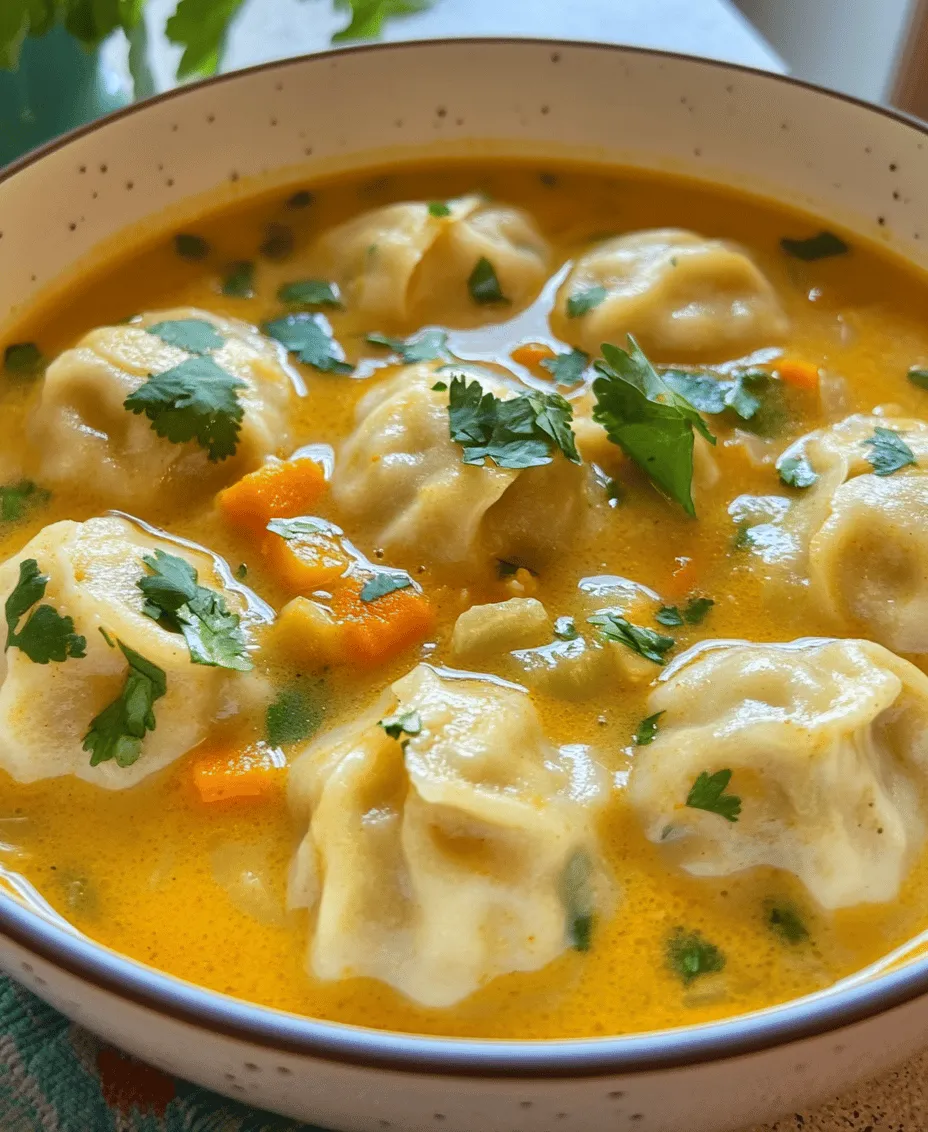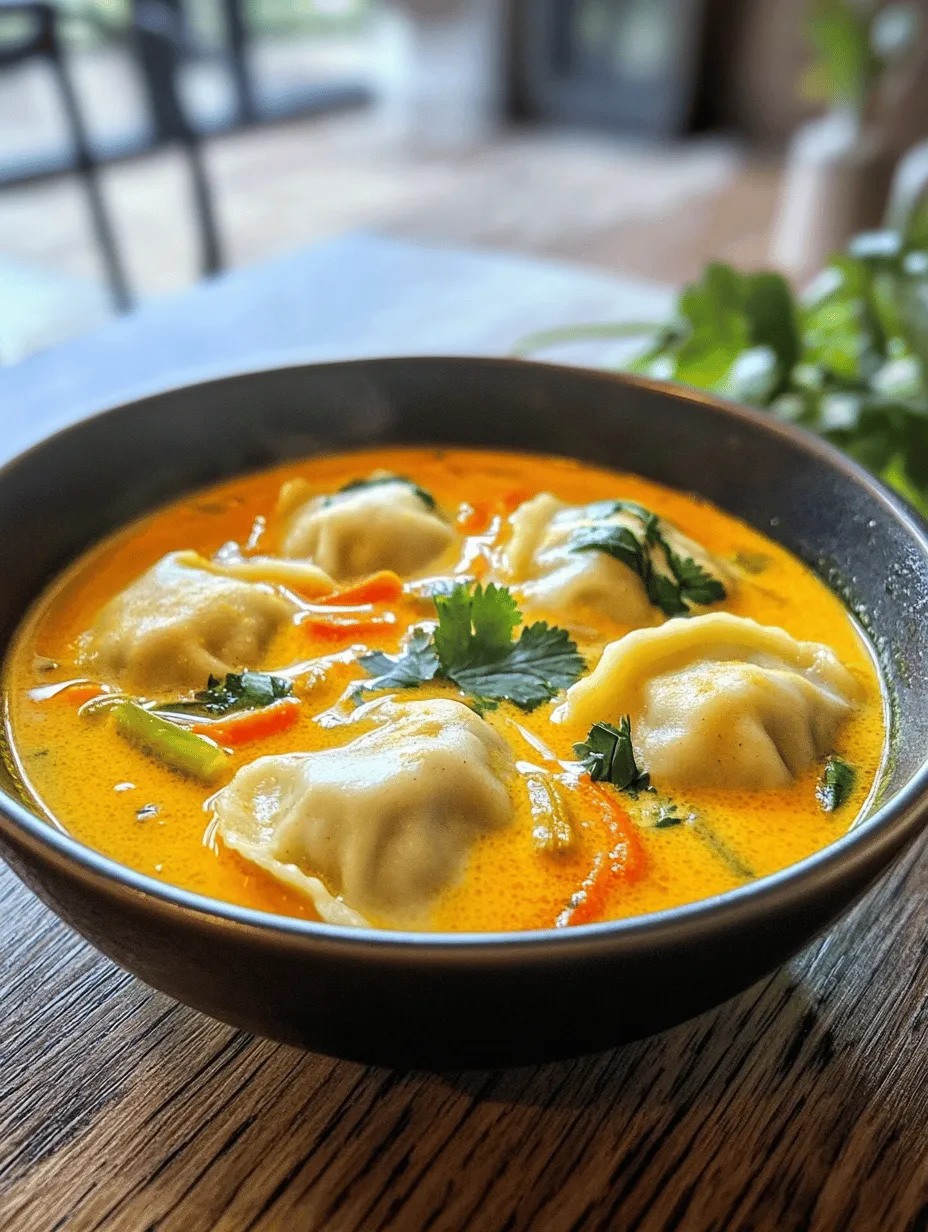Introduction
Curry Dumpling Soup is a delightful fusion of flavor, comfort, and cultural heritage. This dish not only warms the soul with its rich broth but also tantalizes the taste buds with its harmonious blend of spices and textures. Originating from the culinary traditions of various cultures, curry and dumplings have long been cherished for their versatility and satisfying nature. Whether it’s a chilly evening or a gathering with friends and family, a bowl of Curry Dumpling Soup serves as a perfect centerpiece that invites everyone to gather around and enjoy.
The appeal of this dish lies not only in its delicious taste but also in its ability to evoke feelings of nostalgia and comfort. Many cultures around the world have their versions of curry and dumplings, each bringing its unique flair to the table. From Southeast Asian curries that burst with flavor to Eastern European dumplings that are pillowy soft, this dish encapsulates the essence of comfort food. Whether you are in search of a soothing meal after a long day or a dish to impress guests, Curry Dumpling Soup is sure to deliver.
Understanding the Flavor Profile of Curry Dumpling Soup
At the heart of Curry Dumpling Soup is a complex flavor profile that is both inviting and invigorating. The ingredients used in the dish play a crucial role in crafting a broth that is rich, aromatic, and satisfying. The base of the soup is typically built around a combination of spices, fresh herbs, and creamy elements, creating layers of flavor that develop as the soup simmers.
Balancing Spices and Seasonings in Curry Broth
The flavor of the curry broth is largely determined by the balance of spices and seasonings. Key ingredients such as onion, garlic, and ginger form the aromatic backbone, infusing the soup with warmth and depth. The use of red curry paste is essential; it serves as the heart of the dish, providing the signature heat and complexity associated with curry.
To achieve a well-rounded flavor, it is important to balance the spices with other ingredients. Coconut milk adds creaminess and sweetness, while vegetable broth serves as the foundation, enhancing the overall flavor without overpowering the curry notes. The addition of soy sauce, lime juice, and brown sugar contributes layers of umami, acidity, and sweetness, respectively. This careful balancing act is what sets a great curry broth apart from an average one.
The Blend of Textures: Dumplings and Soup
One of the most satisfying aspects of Curry Dumpling Soup is the variety of textures that come together in each spoonful. The dumplings, often filled with fresh vegetables and seasonings, offer a delightful contrast to the smooth, creamy broth. As you bite into the dumpling, you experience a burst of flavor that complements the rich soup, creating a symphony of taste and mouthfeel.
The dumpling dough should be tender yet firm enough to hold its shape while cooking, while the soup remains light and comforting, enveloping the dumplings in its warmth. This combination of textures not only makes the dish visually appealing but also elevates the eating experience, inviting you to savor each bite.
Ingredients Breakdown
To create the best Curry Dumpling Soup, it is essential to gather high-quality ingredients that contribute to the overall flavor and texture of the dish. Below is a detailed breakdown of the key ingredients used in both the curry broth and the dumplings.
Ingredients for the Curry Broth
1. Coconut Oil: This oil is not only a healthier alternative but also contributes a subtle sweetness and richness to the broth. Coconut oil is known for its health benefits, including its medium-chain triglycerides (MCTs), which can provide quick energy and support metabolism.
2. Onion, Garlic, and Ginger: These aromatics form the flavor base of the soup. Onions add sweetness and depth, garlic offers pungency, and ginger provides warmth and a hint of spice. Together, they create a fragrant foundation that enhances the overall flavor of the broth.
3. Red Curry Paste: The star of this dish, red curry paste is a blend of red chiles, garlic, lemongrass, and other spices. It brings a vibrant color and bold flavor to the soup. Variations of red curry paste can be found, and for those who prefer a milder flavor, green curry paste can be a suitable substitute.
4. Vegetable Broth and Coconut Milk: The combination of these two ingredients creates a rich and creamy texture. Vegetable broth adds depth and umami, while coconut milk lends creaminess and a hint of sweetness, making the soup comforting and satisfying.
5. Soy Sauce, Lime Juice, and Brown Sugar: These ingredients work together to add complexity to the broth. Soy sauce introduces a savory element, lime juice offers brightness and acidity, and brown sugar balances the flavors with a touch of sweetness.
Overview of Dumpling Ingredients
1. All-Purpose Flour: This is the primary ingredient for creating the dumpling dough. All-purpose flour provides the right amount of gluten to create a chewy yet tender texture. It is essential to knead the dough properly for the best results.
2. Fresh Vegetables: A variety of fresh vegetables can be used in the dumpling filling, such as finely chopped carrots, mushrooms, spinach, or cabbage. These vegetables not only add flavor but also contribute to the nutritional value of the dumplings.
3. Seasonings: Enhancing the flavor of the dumplings is crucial. Common seasonings include soy sauce, sesame oil, and a pinch of salt or pepper. These ingredients help to elevate the filling and ensure that every bite is bursting with flavor.
Step-by-Step Guide to Preparing Curry Dumpling Soup
Preparation of the Dumpling Dough
The first step in creating Curry Dumpling Soup is to prepare the dumpling dough. This process is straightforward, but attention to detail is key to achieving the perfect consistency.
1. Combine the Flour and Water: Start by measuring out the all-purpose flour into a large mixing bowl. Gradually add water, mixing until the dough begins to come together. The ratio of flour to water is crucial; typically, a ratio of 2:1 works well, but slight adjustments may be necessary based on humidity and flour type.
2. Knead the Dough: Once the dough has formed, transfer it to a floured surface and knead it for approximately 5-7 minutes. The goal is to develop gluten, which will give the dumplings their structure. The dough should be smooth and elastic to the touch.
3. Rest the Dough: After kneading, it is important to let the dough rest. Cover it with a damp cloth or plastic wrap and allow it to rest for at least 30 minutes. This resting period is essential for the gluten to relax, resulting in a more pliable dough that is easier to roll out.
Tips for Achieving the Perfect Dough Consistency
Achieving the right dough consistency is critical for making dumplings that hold up during cooking. Here are some tips to ensure success:
– Check the Texture: The dough should be soft but not overly sticky. If it feels too wet, gradually incorporate small amounts of flour until the desired texture is reached. Conversely, if it feels too dry, add a few drops of water until it becomes workable.
– Knead Thoroughly: Proper kneading not only develops the gluten but also ensures even distribution of moisture throughout the dough. Take your time during this step for the best results.
– Resting is Key: Don’t skip the resting period. This allows the gluten to relax, making it easier to roll out the dough into thin circles for filling.
As you prepare the dumpling dough, you are laying the foundation for a delicious Curry Dumpling Soup that will be both satisfying and comforting. The next steps will delve into filling the dumplings and preparing the flavorful curry broth, setting the stage for a delightful culinary experience.

Creating the Vegetable Filling
To create a delicious and nutritious vegetable filling for your dumplings, start by selecting a mix of colorful and flavorful vegetables. Popular choices include finely chopped cabbage, carrots, bell peppers, mushrooms, and green onions. Each of these vegetables not only adds unique flavors but also brings its own health benefits to the dish.
Suggestions for Vegetable Combinations and Their Nutritional Benefits
1. Cabbage: Rich in vitamins C and K, cabbage is known for its anti-inflammatory properties and digestive health benefits.
2. Carrots: Packed with beta-carotene, carrots are great for eye health and are high in fiber.
3. Bell Peppers: These vibrant vegetables are high in antioxidants and provide a good dose of vitamins A and C.
4. Mushrooms: Adding umami flavor, mushrooms are low in calories and a great source of B vitamins and minerals like selenium.
5. Green Onions: These add a mild onion flavor and are rich in vitamins A and C while also supporting heart health.
Feel free to experiment with other vegetables such as zucchini, spinach, or kale, depending on what you have on hand or prefer. The key is to finely chop the vegetables to ensure they cook evenly and fit nicely inside the dumplings.
Techniques for Seasoning the Filling
Once you’ve prepared your vegetable mix, it’s essential to season it properly. Start by adding salt and pepper to taste. You might also consider incorporating soy sauce or tamari for a savory depth. For an extra kick, add minced ginger and garlic. Fresh herbs like cilantro or basil can elevate the flavor profile and add freshness.
To bind the filling, consider mixing in a little cornstarch or flour, which will help hold everything together and ensure that the dumplings maintain their shape during cooking. Taste the filling before assembling the dumplings to adjust the seasoning if necessary.
Forming the Dumplings
With your filling ready, it’s time to form the dumplings. Begin by rolling out your dough into thin circles. If you’re using store-bought dumpling wrappers, this step is already done for you, but homemade dough can add an extra layer of flavor and texture.
Techniques for Rolling and Cutting the Dough
If making your own dough, combine flour and water to form a firm yet pliable dough. Knead it for about 10 minutes until smooth, then cover it with a damp cloth to prevent it from drying out. Roll the dough into a long log and cut it into small pieces, about 1-inch thick. Flatten each piece with a rolling pin to create thin circles approximately 3 inches in diameter.
If using pre-made wrappers, ensure they are thawed if frozen, and keep them covered with a damp cloth to prevent drying.
Tips for Sealing the Dumplings Effectively
To fill and seal your dumplings, place a teaspoon of the vegetable filling in the center of each wrapper. Be careful not to overfill, as this can lead to bursting during cooking. Moisten the edges of the wrapper with a little water using your fingertip, then fold it in half to create a half-moon shape. Pinch the edges firmly to seal, ensuring no filling escapes. For added security, you can create pleats along the edges, which is also a great way to add visual appeal.
Crafting the Curry Broth
A flavorful curry broth is essential for your dumpling soup. Start by heating a tablespoon of oil in a large pot over medium heat. Add minced garlic, ginger, and diced onions, sautéing until they become fragrant and translucent. This aromatic base is key to building depth in your broth.
Detailed Instructions on Sautéing and Building Flavors
After the onions have softened, add spices such as curry powder, turmeric, and cumin. Toasting the spices for a minute or two will enhance their flavors. Then, pour in vegetable broth and coconut milk, stirring to combine. The coconut milk adds creaminess and a subtle sweetness that balances the spices beautifully.
Importance of Simmering to Develop a Rich Broth
Bring the mixture to a gentle simmer, allowing the flavors to meld for about 15-20 minutes. This simmering process is crucial as it deepens the flavor of the broth and allows the spices to infuse fully. You can add chopped vegetables like carrots or bell peppers to the broth during this time for added texture and flavor.
Cooking the Dumplings in the Broth
With your broth ready, it’s time to add the dumplings. Carefully drop them into the simmering broth, ensuring not to overcrowd the pot. Stir gently to prevent them from sticking to each other or the bottom.
Tips for Ensuring Dumplings Cook Evenly
Cook the dumplings for about 5-7 minutes or until they start to float, which indicates they are cooked through. If you’re using frozen dumplings, they may take a little longer to cook. Keep an eye on them, and adjust the cooking time as needed.
Signs That Dumplings Are Fully Cooked
To check for doneness, cut one dumpling in half. The filling should be hot and cooked through, and the dough should be tender yet firm. Once cooked, remove the dumplings with a slotted spoon and set them aside while you finish the broth.
Serving Suggestions and Presentation
To serve your curry dumpling soup, ladle the broth into bowls and add the dumplings. A sprinkle of fresh cilantro on top adds a pop of color and a burst of freshness. You can also add slices of red chili for a hint of heat, or a squeeze of lime juice for brightness.
Ideas for Garnishing the Soup with Fresh Cilantro
Cilantro not only enhances the visual appeal but also complements the curry flavor. Consider using other garnishes such as sliced green onions, sesame seeds, or a dash of chili oil for an added kick.
Recommendations for Side Dishes or Accompaniments to Enhance the Meal
To round out the meal, serve your soup with a side of steamed rice or crusty bread to soak up the flavorful broth. A simple green salad with a light vinaigrette can also offer a refreshing contrast.
Presentation Tips to Make the Dish Visually Appealing
For an attractive presentation, use deep bowls to showcase the vibrant broth and colorful dumplings. Arrange the dumplings artfully and garnish generously. Consider serving with chopsticks or a decorative spoon for an authentic touch.
Nutritional Insights
This curry dumpling soup is not just comforting and delicious; it’s also packed with nutrients.
Overview of the Health Benefits of Key Ingredients
The combination of fresh vegetables and spices provides an array of vitamins and minerals. The coconut milk adds healthy fats, while the spices offer anti-inflammatory benefits. This dish is naturally vegetarian, and with careful ingredient selection, can easily be made vegan.
Discussion on Vegetarian and Vegan Aspects of the Recipe
By using vegetable broth and ensuring all ingredients are plant-based, this recipe is perfect for those following vegetarian or vegan diets. It’s hearty enough to satisfy even the most dedicated meat-eaters.
Potential for Customization for Dietary Preferences (Gluten-Free Options, Etc.)
For gluten-free options, use rice paper wrappers or gluten-free flour for the dumpling dough. You can also substitute the soy sauce with tamari or coconut aminos. The versatility of the filling allows for the inclusion of various ingredients to cater to different dietary needs.
Conclusion
Curry dumpling soup is a delightful dish that warms the soul, combining the comforting textures of dumplings with the rich and aromatic flavors of curry broth. This recipe offers a perfect opportunity to experiment with different vegetables and spices, leading to a satisfying and nutritious meal.
We encourage you to try making this recipe at home and share the joy of cooking with family and friends. There’s something special about serving a homemade dish that showcases your culinary skills and creativity. Enjoy the process and the delicious results of your hard work!



